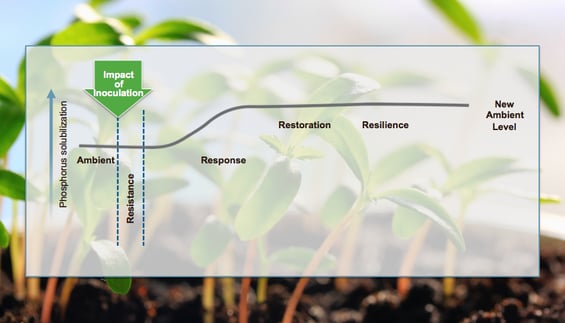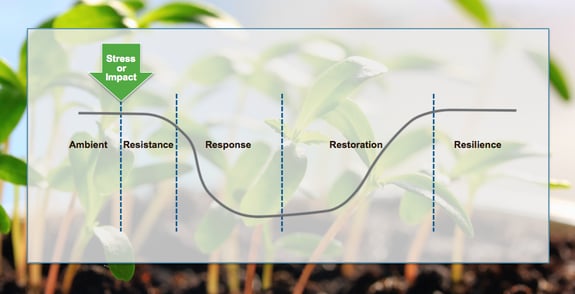By Robert N. Ames, PhD, Scientist Emeritus, Agricen Sciences
Microbial communities in the soil are highly complex and interactive, but the scientific community has only a partial understanding of the functions, or even the identity, of the vast majority of these microorganisms. Even the better-studied ones offer us only glimpses of their functions and capabilities. Thus, we face a significant challenge in trying to define meaningful measurements for microbial functions, especially those that we can relate directly to sustainable crop production. But defining these measurements is important since, as with any system, our ability to influence or manage microbial functions must be guided by quantifiable indicators. Earlier in this blog series, I described a “cycle” of responses to various impacts or stresses in a microbial system. Within that context, it might be useful to illustrate a couple of examples of measurement approaches – one of which would be aimed at managing a negative (or deleterious) effect on the system and the other a beneficial effect. In either case, the measurement approach is aimed at developing management strategies to improve productivity through a positive shift in the cycle of the system.
The first example involves management of a targeted soil-borne plant pathogen. The measurement approach would be to quantify the population of the pathogen, and then relate that quantified level to an estimate of disease severity and subsequent impact on crop yield. Management strategies would then be developed to decrease the pathogen population and maintain it at a level well below that at which the pathogen would be considered to be of economic concern.
In this example, the initial population measurement represents an ambient level prior to taking action for disease control. A stress or impact on the microbial community is introduced by the application of a chemical or biological disease-control product aimed at the target pathogen, rotation to non-host crops or resistant varieties, employment of cultural practices that disfavor the pathogen, or some combination of these actions. Any resistance to a reduction in the pathogen population would be influenced by the forms of infective propagules in the soil, protection within crop residues, the type and amount of control material used, the length of time required for the control material to come into contact with the pathogen and function, and a variety of physical, chemical and environmental factors that may alter efficacy of the control material or disease development. The desired response of the system would be to reduce and hold the pathogen population at a level that would minimize disease. If our measurements are appropriate, then we should be able to quantify the effects of our strategies through each stage of the cycle, with the final success indicator being that of increased crop yield.
Obviously, our goal should include maintaining the system beyond the individual crop season. Our management practices should be geared toward preventing the restoration of the pathogen population and maintaining the resilience of the microbial system. That resilience would be highly dependent on the establishment and maintenance of a microbial community that helped to prevent disease and promote crop productivity.
The second example calls for management strategies to increase the presence and activity of microorganisms that provide beneficial functions to the system. An example of such a function might be phosphorus solubilization – that is, the array of activities that support increased phosphorus availability and uptake by the crop. In this case, our management strategies would be quite different from the plant pathogen example, but with the same goal of increased crop productivity. Thus, the strategy would be to promote the introduction and/or functioning of phosphate-solubilizing microorganisms. The ambient measurements could consist of quantifying particular phosphorus-solubilizing bacteria, measuring phosphatase enzyme activity, using a variety of molecular tools to directly or indirectly assess the microbial community capable of phosphorus mineralization, or simply measuring changes in plant-available soil phosphorus. The impact event, as one approach or management strategy, could consist of the introduction of phosphorus-solubilizing microorganisms. Here, the desired outcome would be to obtain minimal resistance to the establishment of the introduced microorganism and observe a measurable increase in the phosphorus solubilization response. As indicated in the diagram below, the management strategies employed would be directed at minimizing major fluctuations in the restoration or resilience stages so that the “new” ambient level for phosphorus solubilization would be higher than previous measurements. The cycle management strategies would also have to take into account that it is difficult to alter soil phosphorus chemistry and recognize the importance of preventing adverse environmental effects due to the off-site movement of phosphorus.
Example of an ideal “impact cycle” due to inoculation with a phosphorus-solubilizing bacterium and potential for increased phosphorus availability to a crop.
From the above examples of measurements, we can see that there are many considerations and management strategies that come into play depending on the microbial system “cycles” and the desired objectives. In spite of the challenges, there are literally thousands of microbial functions in the soil that have the potential for management to benefit crops.
Microbial technologies that take advantage of these functions can play a critical role in agricultural productivity.



 In agricultural soils, the impact of farming on various species within microbial communities and their functioning may be beneficial or harmful. Many published studies have addressed this subject, comparing conventional, sustainable, organic, or a mixture of practices characteristic of these systems. The results clearly indicate that the different farming practices result in changes in microbial community composition; however, there are no clear correlations between these microbial changes and agricultural productivity.
In agricultural soils, the impact of farming on various species within microbial communities and their functioning may be beneficial or harmful. Many published studies have addressed this subject, comparing conventional, sustainable, organic, or a mixture of practices characteristic of these systems. The results clearly indicate that the different farming practices result in changes in microbial community composition; however, there are no clear correlations between these microbial changes and agricultural productivity.
 As previously mentioned, we can recognize stress on agricultural crops fairly easily based on poor growth, wilting or disease symptoms. However, we rarely consider stresses on the functioning of microorganisms in the soil – mostly because they can’t be easily seen, and we don’t really understand how most of these organisms function. We do know that the life cycle of individual soil microorganisms is short and may be only a few hours or days for many of them. So any disturbance of the soil will have an impact on the microbes present and their functioning within the microbial community.
As previously mentioned, we can recognize stress on agricultural crops fairly easily based on poor growth, wilting or disease symptoms. However, we rarely consider stresses on the functioning of microorganisms in the soil – mostly because they can’t be easily seen, and we don’t really understand how most of these organisms function. We do know that the life cycle of individual soil microorganisms is short and may be only a few hours or days for many of them. So any disturbance of the soil will have an impact on the microbes present and their functioning within the microbial community. Most who are involved in the agricultural industry understand that agricultural productivity is dependent on a variety of crop inputs, management practices and environmental factors that ultimately influence the quantity and quality of the crops harvested, as well as profits for the grower. In recent years, we’ve become very aware of the impact of environmental stresses due to drought, and even excessive rain, on crop yield. It has also been stressed that agricultural productivity must be considerably increased if we’re to meet the demands of an increasing population. Thus, the burden on the agricultural community is to produce more in a sustainable manner that minimizes adverse environmental affects and is minimally impacted by stress conditions. All of these present major challenges, with the ability to minimize environmental stress being the most difficult.
Most who are involved in the agricultural industry understand that agricultural productivity is dependent on a variety of crop inputs, management practices and environmental factors that ultimately influence the quantity and quality of the crops harvested, as well as profits for the grower. In recent years, we’ve become very aware of the impact of environmental stresses due to drought, and even excessive rain, on crop yield. It has also been stressed that agricultural productivity must be considerably increased if we’re to meet the demands of an increasing population. Thus, the burden on the agricultural community is to produce more in a sustainable manner that minimizes adverse environmental affects and is minimally impacted by stress conditions. All of these present major challenges, with the ability to minimize environmental stress being the most difficult.